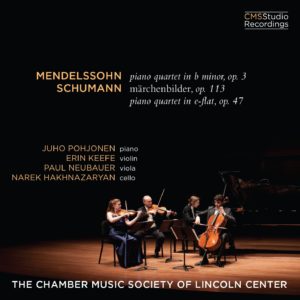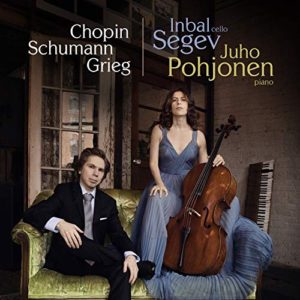
In keeping with the health safety directives from the Santa Clara County Public Health and the federal government regarding the COVID-19 coronavirus situation, we have decided to cancel this concert.
About
Finnish pianist Juho Pohjonen has received widespread acclaim for his profound musicianship and distinctive interpretations of repertoire from Bach to Salonen. His interpretations are known for their intensity, thoughtfulness, and fearless musical conviction. He performs widely in Europe, Asia, and North America. He has won numerous prizes in both Finnish and international competitions. In 2009, Sir András Schiff chose Pohjonen for Germany’s Klavier Festival Ruhr Scholarship and its prestigious invitation to play at the Festival.
Program
- Allegro maestoso
- Andante espressivo—Andante molto
- Scherzo: Allegro energico—Trio
- Intermezzo: Andante molto
- Finale: Allegro moderato ma rubato
- Ondine
- Le gibet
- Scarbo
Program Notes
Like so many other 19th-century composers, Brahms burst to fame as a virtuoso pianist who happened also to compose. But the young composer chose as his model not the recent (and formally innovative) piano music of Liszt and Chopin, but the older classical forms of Haydn, Mozart, and Beethoven. Of Brahms’s first five published works, three were piano sonatas. He completed the last and finest of these sonatas in October of 1853, when he was still only 20 years old.
By coincidence, in that same month Robert Schumann’s article on Brahms appeared in the Neue Zeitschrift für Musik, extravagantly hailing the young composer as one “at whose cradle graces and heroes kept watch,” a composer who would show the world “wonderful glimpses into the secrets of the spirit world.” Schumann had seen several of Brahms’s early manuscripts and significantly referred to “sonatas, or rather veiled symphonies.” Schumann had very probably seen an early version of the Sonata in F Minor; for this massive, heroic sonata has struck many observers as being of orchestral proportions, a symphony masquerading as a piano sonata. It is in five movements rather than the expected three, and the young Brahms apparently set out to wring every bit of sound possible from the piano: the sonata features huge rolled chords; the music races between the highest and lowest ranges of the instrument; and Brahms creates textures so rich in color and sound that virtually every critic who writes about this sonata refers to its orchestral sonorities. Schumann may have hailed Brahms as a “young eagle,” but in this sonata the composer comes on like a young lion.
Brahms marks the sonata-form first movement Allegro maestoso, and majestic it certainly is. This powerful, heroic music grows almost entirely out of the simple thematic shape announced in the first measure. Brahms marks one of the quiet derivations of this theme fest und bestimmt (“firm and determined”), and that might stand as a marking for the entire movement. In sharp contrast, the Andante espressivo is a nocturne, and Brahms prefaces it with a few lines from a poem of Sternau: “The twilight falls, the moonlight gleams, two hearts in love unite, embraced in rapture.” A quiet center section, marked “As gentle and tender as possible,” leads to a return of the opening material and then a stunning coda: over a quiet A-flat pedal, the music gradually rises to a triumphant climax before falling back to end quietly.
The third movement is a lopsided scherzo that leaps across the keyboard; its quiet trio section is entirely chordal. Brahms marks the fourth movement Intermezzo—an unusual movement for a sonata—but even more unusual is the parenthetical subtitle Rückblick (“Reminiscence”). He brings back the theme from the second movement, but now it is very somber—the gentle love song has become a funeral march. This is the movement that seems most orchestral to the critics; and some claim to hear the sounds of timpani, snarling basses, and trumpets as the movement develops dramatically. The finale is a rondo-like movement based on a halting main theme. Along the way, Brahms remembers themes from earlier movements and treats them contrapuntally as the sonata races to its thunderous close.
In his piano music, Brahms turned next to variation form and later to the short pieces he preferred in his mature years; and in these forms he would create some of the greatest music ever
written for the piano. But he apparently felt that with the Sonata in F Minor he had said all the things he wanted to in the form of a solo piano sonata. He never wrote another.
This music—so brief, so lovely—is the work of a boy. Ravel was only 20 when he composed it in November 1895. His friend, the Spanish pianist Ricardo Viñes, gave the premiere at the Salle Érard on April 18, 1898. The Menuet antique was published later that year; it was Ravel’s first published work. The composer retained his affection for the piece. He performed it often; and 30 years later, in 1929, he returned to the work and orchestrated it.
The music may be described simply: it is a minuet in the expected 3/4 meter and ABA form. Its first section, marked Majestueusement (“majestically”), proceeds from the syncopations and slight dissonances of its opening to the poised main theme, which unfolds gracefully between the two hands. The central section, marked doux (“gentle”), sings wistfully, almost nostalgically, and—in a very deft touch—the young composer subtly combines both his main themes before the return of the opening section. The music is beautifully written for the keyboard, and Ravel is scrupulous about indicating pedaling and dynamic markings.
What are we to make of the title? In what sense is this minuet “antique”? The minuet had been out of fashion for about a century when Ravel wrote the work. Perhaps it was that very sense of reaching out to a distant and vanished past that attracted the composer. What has been described as a “mock-archaic manner” was very much a part of Ravel’s aesthetic, as works like Daphnis et Chloé, Le tombeau de Couperin, and others remind us. The form of the Menuet antique may be from the past, but in the precision of the writing, the attention to sound, and the longing for an idealized order, this gentle little piece by a 20-year-old already suggests some of the characteristics of the composer Ravel would become.
Maurice Ravel had a lifelong fascination with magic and the macabre, and this shaped his music in different ways. While still a student at the Paris Conservatory, he fell in love with a curious book written 60 years earlier: Gaspard de la nuit, a collection of prose poems by Aloysius Bertrand (1807–41). Bertrand said that these spooky tales from the Middle Ages were “after the manner of Callot and Rembrandt” (it was an engraving by Jacques Callot—The Huntsman’s Funeral—that inspired the third movement of Mahler’s First Symphony). Bertrand gave these tales a further whiff of brimstone by claiming that the manuscript had been delivered to him by Gaspard himself—an alias for Satan.
Ravel composed Gaspard de la nuit—a set of three pieces that blend magic, nightmare, and the grotesque—in 1908, at the same time he began writing his collection of luminous fairyland pieces for children, Ma mère l’Oye. Bertrand’s prose poems were originally inspired by the visual arts (paintings, etchings, and woodcuts), and in turn—his imagination enlivened by Bertrand’s literary images—Ravel composed these “three poems for piano.” This heterogeneous background makes itself felt in the music, for at its best Ravel’s Gaspard de la nuit blends word, image, and sound.
Each of the three pieces was inspired by a particular prose poem, and Ravel included the texts in the score. But the set should not be understood as the attempt to re-create each tale in music; rather, these pieces evoke the particular mood inspired by Bertrand’s originals. Still, there are moments of such detailed scene painting that one imagines that Ravel must have had specific lines in mind as he wrote.
Ondine pictures a water sprite who tempts mortal men to her palace beneath the lake. Ravel’s shimmering music evokes the transparent, transitory surfaces of Bertrand’s text, the final line of which reads: “And when I told her that I was in love with a mortal woman, she began to sulk in annoyance, shed a few tears, gave a burst of laughter, and vanished in a shower of spray which ran in pale drops down my blue windowpanes.” It is impossible not to hear a conscious setting of these images over the closing moments of this music, which vanishes as suddenly as the water sprite herself.
Le gibet (“The Gallows”) evokes quite a different world. All commentators sense the influence of Poe here (during his American tour of 1928, Ravel made a point of visiting Poe’s house in Baltimore). Bertrand’s text begins with a question: “Ah, what do I hear? Is it the night wind howling, or the hanged man sighing on the gallows?” He considers other possibilities, all of them horrible, and finally offers the answer: “It is the bell that sounds from the walls of a town beyond the horizon, and the corpse of a hanged man that glows red in the setting sun.” Muted throughout, this piece is built on a constantly repeated B-flat, whose irregular tolling echoes the sound of that bell.
The concluding movement Scarbo is a portrait of a bizarre creature—part dwarf, part rogue, part clown—who seems to hover just outside clear focus. The text concludes: “But soon his body would start to turn blue, as transparent as candle wax, his face would grow pale as the light from a candle end—and suddenly he would begin to disappear.” Ravel’s music—with its torrents of sound, sudden stops, and the unexpected close—suggests different apparitions of the demonic creature.
Gaspard de la nuit is music of stupefying difficulty for the performer, by design: Ravel consciously set out to write a work that would be more difficult than Balakirev’s Islamey, one of the greatest tests for pianists. (Alert listeners may detect hints of the beginning of Islamey in Scarbo, perhaps an act of homage on the part of Ravel.) In his effort to write blisteringly difficult music for the pianist, Ravel succeeded brilliantly. From the complex and finger-twisting chords of Ondine through the dense textures of Le gibet (written on three staves) and the consecutive and rapid intervals of seconds of Scarbo, Gaspard de la nuit presents hurdles that make simply getting the notes right almost impossible. And only then can the pianist set about creating the range of tone color, dynamics, and pacing that bring this evanescent music to life.
Listen
Buy Music
Steinway Society The Bay Area is a participant in the Amazon Services LLC Associates Program, an affiliate advertising program designed to provide a means for sites to earn advertising fees by advertising and linking to Amazon.com

